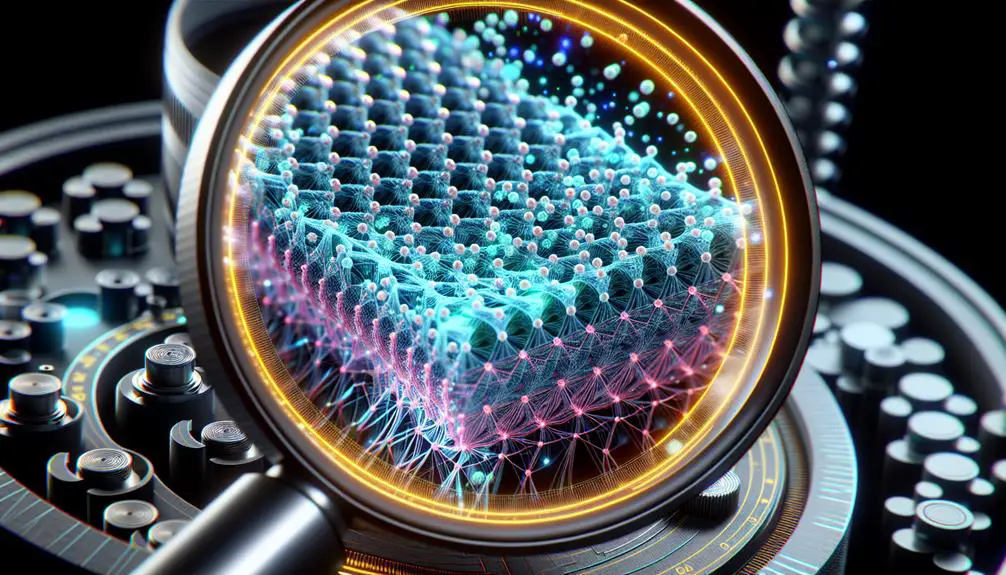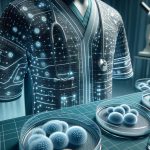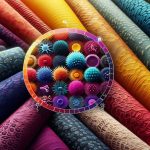Imagine wearing a shirt that stays wrinkle-free all day or a jacket that repels water and stains effortlessly. With nanotechnology in fabrics, these aren't just futuristic fantasies but current realities. You can now enjoy enhanced durability, built-in UV protection, and even temperature-regulating capabilities in your everyday clothing. These textiles can maintain hygiene with self-cleaning and antimicrobial properties, and some even monitor your health with embedded microscopic sensors. Interested in how these innovations are reshaping what you wear? Let's explore how nanotechnology is redefining fabric performance and functionality beyond your expectations.
Table of Contents
Key Takeaways
- Nanotechnology in fabrics enhances stain resistance and color retention with microscopic particles.
- Wrinkle-resistant textiles use nano coatings for durability and crisp appearance.
- Self-cleaning materials repel water and resist odors, reducing washing frequency.
- Embedded microscopic sensors in fabrics enable real-time health monitoring.
- Nanotechnology improves fabric strength, tear resistance, and abrasion resistance for longer-lasting wear.
Stain-Resistant Fabrics
Utilizing nanotechnology, stain-repelling fabrics repel liquids and resist dirt more effectively than traditional materials. By incorporating microscopic particles into the fabric, you can benefit from advanced waterproof technology that guarantees spills bead up and roll off instead of soaking in. This not only keeps your clothing looking pristine but also simplifies maintenance, reducing the need for frequent washing.
Nanotechnology enhances color retention, meaning your fabrics maintain their vibrant hues even after multiple washes. This is vital for anyone who values the longevity of their wardrobe. Additionally, these fabrics are designed to prevent odors from clinging to the material, keeping your garments fresher for longer periods. Odor prevention is a game-changer, especially for active individuals or those in demanding environments.
Static control is another advantage of nanotech-enhanced fabrics. By minimizing static electricity, your clothing will be more comfortable to wear and less likely to cling awkwardly. This feature is particularly useful in dry climates or during the winter months when static tends to be more problematic.
In essence, nanotechnology offers a range of benefits that go beyond simple stain resistance, contributing to overall fabric performance and user satisfaction.
Wrinkle-Resistant Textiles
You'll find that wrinkle-resistant textiles benefit greatly from advanced fabric coatings, which keep your clothes looking smooth. These innovations also enhance the durability of your garments, making them last longer.
Plus, we'll share some maintenance and care tips to keep your wrinkle-free fabrics in top shape.
Advanced Fabric Coatings
Advanced fabric coatings have revolutionized wrinkle-resistant textiles, making them more durable and easier to maintain. Imagine wearing a crisp shirt all day without worrying about unsightly creases. These innovative coatings not only resist wrinkles but also incorporate water repellent technology, ensuring your clothes remain dry and stain-free. No longer will you need to fret over spills or inclement weather; your wardrobe stays impeccable, giving you one less thing to worry about.
Additionally, heat retention coatings have been integrated into these advanced textiles, offering enhanced comfort during cooler months. These coatings trap body heat, keeping you warm without adding bulk, so you can stay stylish and comfortable no matter the season.
This dual functionality—wrinkle resistance and thermal regulation—sets a new standard for high-performance fabrics.
Enhanced Durability Features
Imagine a world where your clothes look fresh and crisp all day, thanks to wrinkle-resistant textiles boasting enhanced durability features. You no longer have to worry about constant ironing or unsightly creases. Nano reinforced strength is the game-changer here, embedding nanomaterials into the fabric to guarantee it withstands the rigors of daily wear. This technology doesn't just make your clothes look good; it also enhances their long lasting performance.
When you invest in wrinkle-resistant textiles with nano reinforced strength, you're investing in wearable durability. These fabrics are designed to endure the test of time, providing you with unparalleled fabric longevity. The nano-enhancements make the fibers more resilient, so they resist tears and abrasions better than conventional materials. This means you can wear your favorite pieces more frequently without compromising their appearance or quality.
Ultimately, wrinkle-resistant textiles featuring advanced nanotechnology offer a leap forward in both style and substance. They combine the convenience of low-maintenance care with the robustness of enhanced durability. You'll appreciate the long-term benefits of these innovative fabrics, as they keep you looking sharp and feeling confident, day in and day out.
Maintenance and Care Tips
To keep your wrinkle-resistant textiles in peak condition, follow these vital maintenance and care tips. Securing fabric longevity requires a bit of attention, but the results are worth it.
Start by mastering the washing instructions specific to your textiles. Most wrinkle-resistant fabrics fare best in cold water using a gentle cycle. Avoid bleach, as it can break down the nanotechnology embedded in the fibers.
When it comes to drying, opt for low heat settings. High heat can degrade the fabric's wrinkle-resistant properties over time. If you prefer air drying, make sure your textiles are spread out evenly to avoid any unwanted creases.
Proper storage is also pivotal for maintaining your fabric's integrity. Store your wrinkle-resistant garments in a cool, dry place. Hanging them on padded hangers can prevent unnecessary folds and wrinkles.
- Washing: Use cold water and a gentle cycle.
- Drying: Opt for low heat or air dry evenly.
- Storage: Hang on padded hangers in a cool, dry place.
Health Monitoring Clothing
With nanotechnology integrated into fabrics, health monitoring clothing can track essential signs and provide real-time data. Imagine wearing a shirt that continuously monitors your heart rate, temperature, and respiratory rate. This isn't science fiction; it's now a reality. By embedding microscopic sensors into the fabric, these clothes offer precise critical sign monitoring, making it easier to track your health without bulky equipment.
If you're into fitness, this technology takes your workout to the next level. Fitness tracking technology embedded in your attire can measure your activity level, steps taken, and even the quality of your sleep. You'll get instant feedback on your performance, helping you optimize your routines and achieve your fitness goals faster.
Moreover, these advanced fabrics can notify you of any irregularities in your crucial signs, potentially alerting you to health issues before they become serious. This proactive approach can be a game-changer for both athletes and those managing chronic conditions.
The integration of nanotechnology in clothing isn't just a trend; it's a revolutionary step towards seamless, continuous health monitoring. You're not just wearing clothes; you're donning a personal health assistant.
Self-Cleaning Materials
Beyond health monitoring, nanotechnology is also making waves in the field of self-cleaning materials. Imagine fabrics that repel water, resist odors, and stay clean longer, all thanks to innovative nanocoatings. These advancements aren't just futuristic concepts; they're rapidly becoming a reality, making your life easier while being eco-friendly.
Nanotechnology enables the development of water repellent technology, where tiny nanoparticles create a barrier on the fabric's surface. This barrier prevents water and other liquids from soaking in, allowing spills to simply roll off. No more worrying about coffee stains on your favorite shirt!
Odor resistant fabrics are another marvel of nanotechnology. By incorporating antimicrobial nanoparticles, these fabrics fight off bacteria that cause unpleasant smells. Say goodbye to frequent washing and hello to fresher clothes.
Here's why self-cleaning materials are a game-changer:
- Ease of Maintenance: Less frequent washing saves time and water.
- Eco-Friendly Solutions: Reduced need for detergents and less water usage contribute to a greener planet.
- Extended Wear: Fabrics last longer and stay fresher, enhancing your overall experience.
Embrace these innovations and stay ahead of the curve with self-cleaning, nanotechnology-enhanced fabrics.
Enhanced Durability
You'll find that nanotechnology enhances the durability of fabrics noticeably.
By incorporating nanoparticles, fabrics gain increased tear resistance and improved abrasion resistance.
This means your clothes will last longer and withstand more wear and tear.
Increased Tear Resistance
Nanotechnology greatly boosts the tear resistance of fabrics, making them more long-lasting for everyday use. Imagine your favorite clothes lasting longer and retaining their quality despite frequent wear and tear. By integrating nanoparticles into the textile fibers, the tear strength of the fabric improves significantly. This means you won't have to worry about your clothes ripping easily, giving you peace of mind and better value for your money.
You'll find that nanotechnology in fabrics offers multiple benefits:
- Enhanced Tear Strength: Nanoparticles create stronger bonds within the fabric, increasing its resistance to tearing.
- Extended Fabric Durability: With enhanced structural integrity, your clothes can withstand more stress and last longer.
- Better Investment: Durable fabrics reduce the need for frequent replacements, saving you money over time.
For those aiming for mastery, understanding these advancements is essential. The incorporation of nanotechnology doesn't just stop at making fabrics tougher; it also guarantees that the material remains lightweight and comfortable. You're not just getting durability; you're getting enhanced performance without compromising on comfort.
Mastering the intricacies of these innovations will enable you to make more informed choices in your textile selections, appreciating the blend of science and fashion.
Improved Abrasion Resistance
Frequently, fabrics treated with nanotechnology exhibit greatly enhanced abrasion resistance, ensuring they remain durable and look new longer. By integrating nanoparticles into the fibers, you're not just improving the surface but reinforcing the very structure of the fabric. This nanoparticle integration provides a shield against wear and tear, making your garments withstand daily use without showing signs of distress.
Fiber reinforcement through nanotechnology doesn't merely add a superficial layer of protection; it fundamentally alters the fabric's properties. When applied, these innovations make the material tougher and more resilient. This is particularly advantageous in wearable technology, where durability is paramount. Imagine your favorite smart jacket or fitness gear lasting notably longer while maintaining its functionality and appearance.
Nanofiber applications are revolutionizing the textile industry. By embedding tiny, durable fibers within the fabric, manufacturers create products that resist abrasion far better than traditional materials. This means your clothes, upholstery, and even industrial fabrics can endure more rigorous conditions without compromising quality.
Incorporating these cutting-edge advancements, you can enjoy textiles that not only look better but also perform better over time. Embrace the future of fabrics with enhanced durability, and experience the remarkable resilience that nanotechnology offers.
UV Protection
Incorporating nanotechnology in fabrics significantly enhances their capacity to shield against harmful UV rays. You're not just safeguarding yourself from the sun; you're embracing a leap forward in sustainable manufacturing and innovative design. These fabrics are engineered at the molecular level to offer superior UV protection without compromising on comfort or style.
By selecting UV-protective nanotech fabrics, you gain:
- Sustainable manufacturing: These fabrics are often produced using eco-friendly alternatives that lessen environmental impact.
- Innovative styling: Advanced materials guarantee that UV protection doesn't entail heavy or uncomfortable attire, keeping you trendsetting.
- Extended longevity: Nanotech fabrics uphold their protective qualities for a longer period, delivering enduring value.
You don't have to compromise on style for protection. With a variety of trendsetting, eco-friendly choices accessible, you can confidently stroll in the sun knowing you're shielded.
The incorporation of nanotechnology into fabrics offers a myriad of options that cater to your preferences while providing exceptional UV resistance. This state-of-the-art approach ensures that your wardrobe isn't only fashionable but also in line with the latest advancements in textile technology.
Temperature Regulation
Harnessing nanotechnology in fabrics means you can stay cool and comfortable, regardless of the temperature. Imagine wearing a shirt that adjusts its properties to keep you warm on a chilly morning and cool during a hot afternoon. With energy-efficient heating and intelligent cooling technology, this isn't just a fantasy—it's the future of clothing.
Energy-efficient heating elements embedded within the fabric can generate warmth without bulk. These tiny, flexible heaters are powered by minimal electricity, ensuring you're cozy without unnecessary energy consumption. This innovation is particularly useful for athletes and outdoor enthusiasts who need reliable warmth without the burden of traditional layers.
On the flip side, intelligent cooling technology utilizes advanced nanomaterials to dissipate heat away from your body. These fabrics can detect when your body temperature rises and respond by increasing breathability or even actively cooling your skin. This is achieved through phase-change materials that absorb excess heat and release it when you cool down, maintaining an ideal temperature balance.
Antimicrobial Properties
Imagine wearing clothes that stay fresh for days without needing a wash, thanks to the antimicrobial properties of nanotechnology. By integrating bacteria killing textiles into fabrics, you're able to enjoy garments that actively repel germs and prevent odors. This isn't just a convenience—it's a game-changer for both hygiene and longevity of your wardrobe.
Nanotechnology enables the development of microbe fighting materials that are woven into the very fibers of the fabric. These innovations bring several benefits:
- Odor resistant fabrics: Say goodbye to unpleasant smells caused by bacteria. Your clothes will stay fresh longer.
- Germ repelling clothing: Reduce your exposure to harmful microbes, promoting better health and cleanliness.
- Enhanced durability: Frequent washing can wear out fabrics. With antimicrobial properties, your clothes retain their quality for a longer time.
Frequently Asked Questions
How Does Nanotechnology Impact the Environmental Sustainability of Fabrics?
You'll find that nanotechnology reduces energy consumption and enhances fabric recyclability. Additionally, it improves biodegradability and introduces eco-friendly coatings, making fabrics more sustainable and aligning with environmental goals.
What Are the Potential Health Risks Associated With Nanotechnology in Fabrics?
Imagine Pandora's box; you never know what's inside until it's opened. With nanotechnology, health risks could emerge, compromising consumer safety. Potential issues include skin irritation, respiratory problems, and unknown long-term effects requiring thorough study.
Can Nanotechnology in Fabrics Increase Production Costs for Manufacturers?
Yes, nanotechnology can increase production costs due to innovation and advanced materials. However, the cost implications might be offset by improved production efficiency and higher market demand for these advanced fabrics, ultimately benefiting manufacturers in the long run.
How Long Do Nanotechnology-Enhanced Fabric Benefits Typically Last?
Just as Excalibur's magic endured, nanotechnology-enhanced fabrics often maintain their longevity and performance for years. However, their maintenance and durability depend on usage and care, ensuring they withstand the test of time like legendary artifacts.
Are There Any Ethical Concerns Related to the Use of Nanotechnology in Textiles?
You might face ethical concerns like privacy issues and consumer acceptance. Ensuring regulatory compliance and worker safety is vital. Master these elements to navigate the complex landscape of nanotechnology in textiles effectively.
- Tetron Fabric for Marine Applications: Durability and Use Cases - June 18, 2025
- Tetron Fabric for Outdoor Furniture: Weather Resistance and Care - June 18, 2025
- Tetron Fabric for Wall Coverings: Style and Application Tips - June 18, 2025







